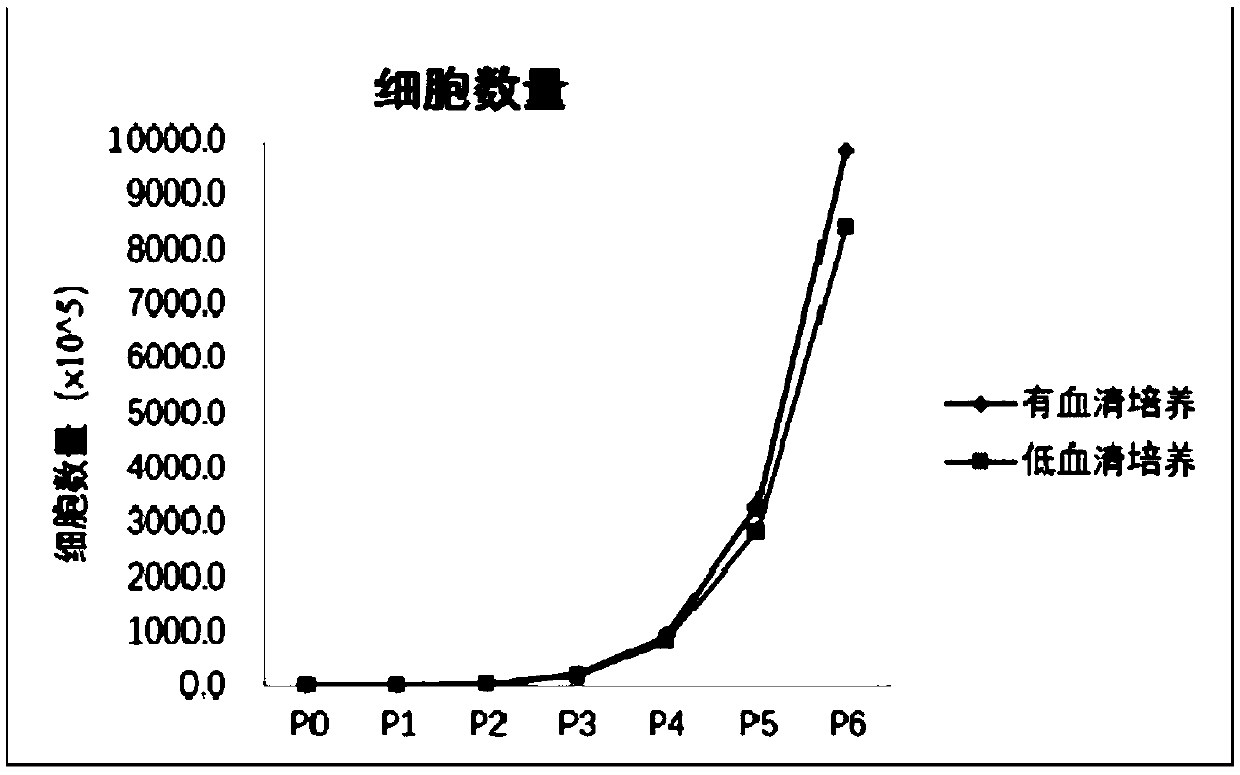Mesenchymal stem cell, cell culture media and culture method and application
A culture method, mesenchymal stem cell technology, applied in the field of cell culture medium and culture method and application, mesenchymal stem cells, can solve the problems of serum batch difference, heterogeneous pollution, unfavorable cell culture, etc., to avoid heterogeneity Contamination, stable and efficient immune rejection, and the effect of simple and easy-to-operate culture methods
- Summary
- Abstract
- Description
- Claims
- Application Information
AI Technical Summary
Problems solved by technology
Method used
Image
Examples
Embodiment 1
[0091] This embodiment provides a method for culturing mesenchymal stem cells, specifically as follows:
[0092] 1. Separation of the umbilical cord
[0093] 1) Take a 5cm-long healthy donated umbilical cord, rinse it with normal saline, and remove the vascular tissue. Shredded to 1mm 3 tissue fragments;
[0094] 2) The tissue fragments were inoculated on a 150mm petri dish, and the first medium was slowly added until the tissue fragments were submerged, and incubated at 36°C, 6% CO 2 Cultivated in an incubator with saturated humidity;
[0095] 3) Change the first medium every other day until the confluence of the adherent cells crawling out of the tissue fragments reaches 90% and then subculture (the cell generation is p0 generation);
[0096] 2. Subculture of umbilical cord mesenchymal stem cells (gradual domestication)
[0097] 1) The primary cells (generation p0) were digested with 0.15% trypsin for 7 minutes to form single cells, and the trypsin reaction was terminat...
Embodiment 2
[0108] This embodiment provides a method for culturing mesenchymal stem cells, specifically as follows:
[0109] 1. Separation of the umbilical cord
[0110] 1) Take a 5cm-long healthy donated umbilical cord, rinse it with normal saline, and remove the vascular tissue. Shredded to 1mm 3 tissue fragments;
[0111] 2) The tissue fragments were inoculated in a 150mm petri dish, slowly added the first medium until the tissue fragments were covered, and placed at 38°C, 4% CO 2 Cultivated in an incubator with saturated humidity;
[0112] 3) Change the first medium every 3 days until the confluence of the adherent cells climbing out of the tissue fragments reaches 80% and then subculture (the cell generation is p0 generation);
[0113] 2. Subculture of umbilical cord mesenchymal stem cells (gradual domestication)
[0114] 1) The primary cells (generation p0) were digested with 0.35% trypsin for 3 minutes to form single cells, and the trypsin reaction was terminated with the seco...
Embodiment 3
[0124] This embodiment provides a method for culturing mesenchymal stem cells, specifically as follows:
[0125] 1. Separation of the umbilical cord
[0126] 1) Take a 5cm-long healthy donated umbilical cord, rinse it with normal saline, and remove the vascular tissue. Shredded to 1mm 3 tissue fragments;
[0127] 2) The tissue fragments were inoculated on a 150mm petri dish, and the first medium was slowly added until the tissue fragments were submerged, and incubated at 37°C, 5% CO 2 Cultivated in an incubator with saturated humidity;
[0128] 3) Change the first medium every 2 days until the confluence of the adherent cells crawling out of the tissue fragments reaches 85% and then subculture (the cell generation is p0 generation);
[0129] 2. Subculture of umbilical cord mesenchymal stem cells (gradual domestication)
[0130] 1) The primary cells (generation p0) were digested with 0.25% trypsin for 5 minutes to form single cells, and the trypsin reaction was terminated ...
PUM
 Login to View More
Login to View More Abstract
Description
Claims
Application Information
 Login to View More
Login to View More - R&D Engineer
- R&D Manager
- IP Professional
- Industry Leading Data Capabilities
- Powerful AI technology
- Patent DNA Extraction
Browse by: Latest US Patents, China's latest patents, Technical Efficacy Thesaurus, Application Domain, Technology Topic, Popular Technical Reports.
© 2024 PatSnap. All rights reserved.Legal|Privacy policy|Modern Slavery Act Transparency Statement|Sitemap|About US| Contact US: help@patsnap.com










